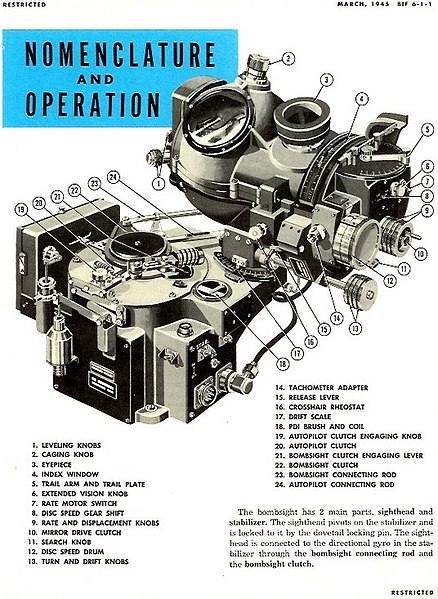A page from the Bombardier's Information File (BIF) that describes the components and controls of the Norden bombsight. The Norden bombsight was a highly sophisticated optical/mechanical analog computer used by the United States Army Air Force during World War II, the Korean War, and the Vietnam War to aid the pilot of a bomber aircraft in dropping bombs accurately.
An analog computer (spelled analogue in British English) is a form of computer that uses the continuously-changeable aspects of physical phenomena such as electrical, mechanical, or hydraulic quantities to model the problem being solved. In contrast, digital computers represent varying quantities incrementally, as their numerical values change.
Mechanical analog computers were very important in gun fire control in World War II and the Korean War; they were made in significant numbers. In particular, development of transistors made electronic analog computers practical, and before digital computers had developed sufficiently, they were commonly used in science and industry.
Analog computers can have a very wide range of complexity. Slide rules and nomographs are the simplest, while naval gun fire control computers and large hybrid digital/analogue computers were among the most complicated. Digital computers have a certain minimum (and relatively great) degree of complexity that is far greater than that of the simpler analog computers. This complexity is required to execute their stored programs, and in many instances for creating output that is directly suited to human use.
Setting up an analog computer required scale factors to be chosen, along with initial conditions – that is, starting values. Another essential was creating the required network of interconnections between computing elements. Sometimes it was necessary to re-think the structure of the problem so that the computer would function satisfactorily. No variables could be allowed to exceed the computer's limits, and differentiation was to be avoided, typically by rearranging the "network" of interconnects, using integrators in a different sense.
Running an electronic analog computer, assuming a satisfactory setup, started with the computer held with some variables fixed at their initial values. Moving a switch released the holds and permitted the problem to run. In some instances, the computer could, after a certain running time interval, repeatedly return to the initial-conditions state to reset the problem, and run it again.
Creative Commons: Wikipedia

No comments:
Post a Comment